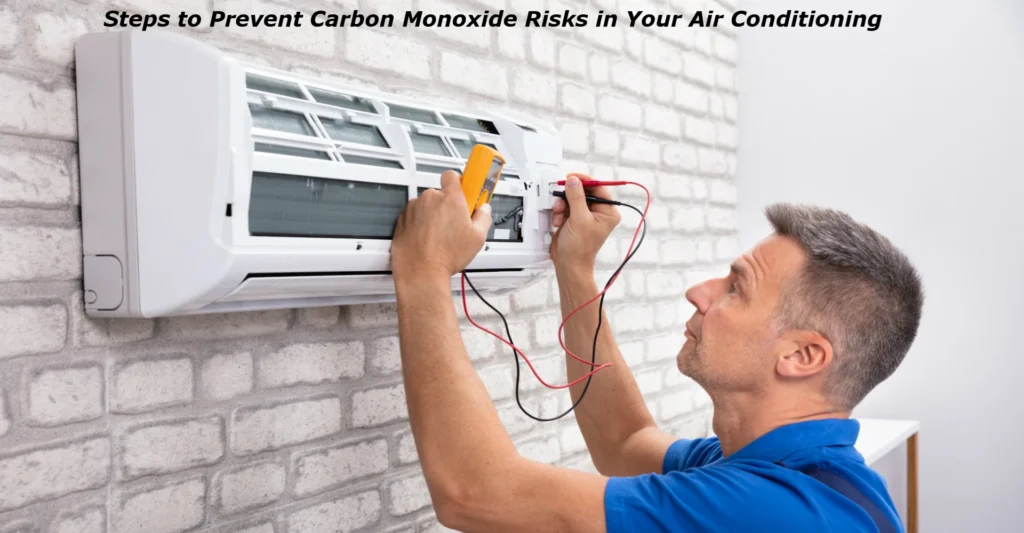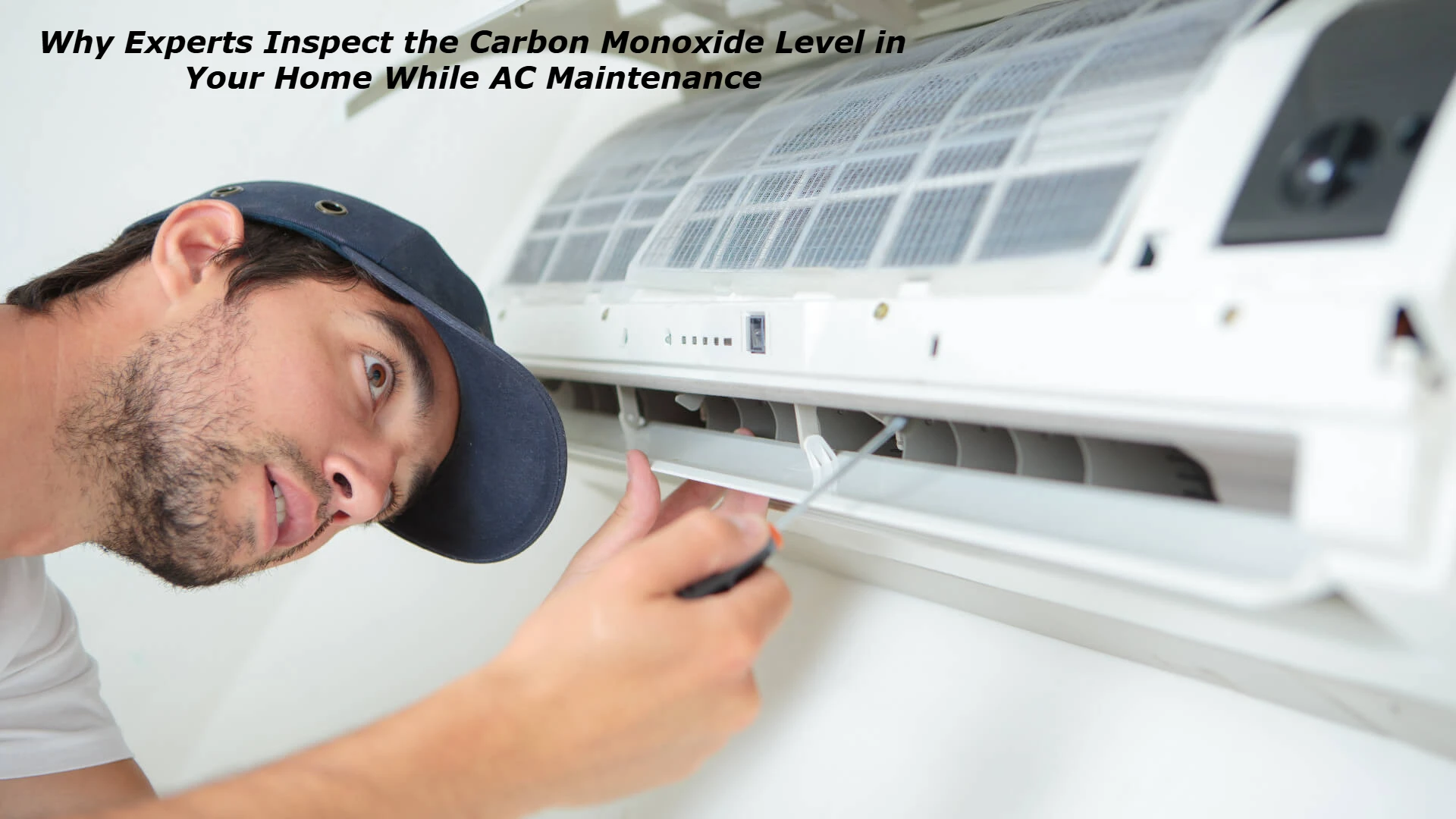
When it comes to AC maintenance, your residence’s safety comes first. Regular AC maintenance is one of the most important factors in checking for carbon monoxide (CO) levels. The first carbon monoxide is a gas without smell or color that can cause major health problems if it is not discovered on time.
In this article, we will explore why experts inspect the carbon monoxide level in your home during AC maintenance, how to detect carbon monoxide, and steps to prevent carbon monoxide risks in your air conditioning
What is Carbon Monoxide?
Carbon monoxide(CO) is a scentless, tasteless, and invisible gas that cannot be detected without special tools. CO is produced when you burn fuels such as propane, wood, coal, or other natural gas. Unfortunately, breathing high levels of CO can be dangerous to humans. Inhaling too much CO can cause headaches, drowsiness, lethargy, nausea, dizziness, and chest pain. In severe circumstances, it can be lethal.
One reason you are unable to relax in a closed garage while your car is running is that autos emit a lot of CO. It can be hazardous for youngsters, the elderly, and anyone who works in a closed-off area, such as welders, firefighters, auto mechanics, and even toll system operators. We establish acceptable CO levels in workplaces. Employers cannot expose their employees to ambient air containing more than 35 parts per million of carbon monoxide.
The Importance of a Carbon Monoxide Detector
Carbon monoxide devices come in a variety of shapes and designs. Many depend on the detection devices that revolve around the first levels of carbon monoxide throughout the day, allowing them to determine the changes in the surrounding air. They also manufacture batteries powered by batteries detectors with quiet sensor technology, which is convenient because they use little electricity. Every home should have a minimum of one, but we believe this is enough for a multi-story home with more than 2,000 square feet of space. If in doubt, we would go to building codes for detailed specifications. It is critical to properly install these and avoid placing them too close to heat-producing sources such as an oven. Otherwise, it would constantly emit false positives, similar to your smoke sensor.
Can Carbon Monoxide Come from AC?
No, air conditioners (ACS) do not produce the first carbon monoxide (CO) because it works on energy and does not require combustion. The first carbon monoxide is usually produced by devices that burn fuel, such as gasoline ovens, heaters, and water heaters when fuel, such as gas, oil, or wood, is not adequately produced. However, if the HVAC system in Dubai includes your home includes a gas-powered oven, it may cause a broken heat exchanger or dead end in the occurrence of a leakage of carbon dioxide. To avoid risks, normal AC maintenance scheduling in Dubai, install the first carbon monoxide detectors, and ensure enough airflow in your home.
How to Detect Carbon Monoxide
Carbon monoxide (CO) is a colorless, odorless, and tasteless gas that can be fatal if it is breathed in large quantities, so detection is very important for safety. The most effective technology to detect carbon monoxide is to place carbon dioxide detectors in strategic locations all over your home, such as nearby bedrooms and equipment that burns fuel. These detectors are available in varieties with batteries, additional components, and solid components, and include features such as LCD screen screens and alarm systems that teach you when CO reaches harmful levels.
In addition to using detection devices, watch the signs, such as dizziness, headache, and nausea, which can indicate a leak. Regular maintenance of fuel devices, such as ovens, water heaters, and stoves, is another way to reduce CO accumulation. Eager to ensure adequate ventilation and keeping stoves and holes free of obstacles are critical measures to reduce risk. If the first carbon monoxide is found, the exit from the site quickly and the pure air can save lives.
What Causes Carbon Monoxide in HVAC?
Carbon monoxide (CO) in HVAC systems is primarily caused by the insufficient combustion of fuels in the heat instead of cooling parts of the system. The following are some factors that can create CO in HVAC systems:
-
Malfunctioning Furnaces:
The furnaces are usual pieces of the HVAC system that produce heat through burning fuels such as natural gas, heating oil, or propane. An incorrect oven may not completely burn fuel, resulting in the creation of carbon monoxide.
-
Poor Ventilation:
Lack of airflow in the area around the furnace can lead to the accumulation of carbon monoxide. Sufficient airflow is required to properly launch outdoor combustion products.
-
Cracked Heat Exchangers:
The heat exchanger is the furnace component that isolates the heat resulting from the burning of the air flowing through the system. If the heat exchanger is broken or harmful, the first carbon monoxide may be mixed with the air that rotates across your home.
-
Blocked Flues or Vents:
Chimneys and openings aim to transfer combustion such as the first carbon monoxide, away from your home. If chimneys or ventilation become banned or crowded, gases may return to your residence.
-
Improperly Installed or Maintained Systems:
HVAC systems must be installed and maintained by qualified professionals. Inadequate installation or lack of maintenance can lead to combustion problems and carbon monoxide leaks.
-
Old or Inefficient Equipment:
Old air conditioning systems may have outdated components, which reduces the effectiveness of combustion. Updating to newer, more effective technology can help lessen the likelihood of carbon monoxide leakage.
-
Use of Unvented Appliances:
Using unvented or inadequately vented equipment that burns fuel indoors, such as natural gas stoves or unvented heaters for spaces, can raise indoor CO levels.

Steps to Prevent Carbon Monoxide Risks in Your Air Conditioning
Carbon monoxide (CO) dangers in your air conditioning system can be reduced by keeping your cooling system in good working order and implementing safety precautions. While AC units do not emit CO, they can directly trigger CO accumulation if certain parameters are unsatisfied. Here are some things you may take to reduce carbon monoxide threats in your air conditioning:
-
Regular Maintenance:
Scheduling regular checks for your HVAC system in Dubai, which includes both cooling and heating systems. A clean system is less likely to have faults that result in Carbon monoxide production.
-
Professional Inspection:
Hire an experienced AC service Dubai to check your air conditioning system, especially when it is a split system with a furnace or another heating element. They can investigate any possible combustion-related problems.
-
Combustion System Checks:
If your air conditioning system contains a furnace or heating part, make sure it’s thoroughly evaluated for its combustion effectiveness and that any necessary repairs or modifications are made right away.
-
Proper Ventilation:
Make sure your HVAC system’s Dubai outflow vents are clear to efficiently direct gases, like carbon monoxide, outside your living quarters. Effective airflow is critical in preventing CO accumulation.
-
Carbon Monoxide Detectors:
Even though air conditioners do not emit CO, having carbon monoxide detectors installed in your residence is crucial. Install them near beds and other important spaces, as they may alert you to high levels of CO from other places.
-
Appliance Ventilation:
To prevent CO accumulation indoors, ensure that any devices that use fuel (such as natural gas water heaters or stoves) are adequately vented to the outside.
-
Educate Household Members:
Provide your family about the dangers of the gas and the significance of detecting the symptoms. Ensure that everyone understands what to do if a carbon monoxide detector comes off or if they get symptoms.
-
Regularly Check Appliances:
Keep a watch on all fuel-burning appliances, including your air conditioner. Check for any symptoms of a problem, such as yellow or orange fires in gas-powered appliances.
-
Install Detectors Near AC Systems:
Although AC units do not emit CO, it is nevertheless advisable to keep CO detectors near the HVAC system to check for any unforeseen leaks from other sources.
-
Professional Installation:
If you are installing new HVAC equipment, use a professional to guarantee that everything is installed securely and correctly.
Conclusion
Regular AC maintenance is essential to keep your home safe and your cooling system works without problems. In areas such as the maintenance of AC Dubai, where air conditioners are frequently used, it is essential to ensure that they are examined and maintained regularly. Although air conditioners do not produce carbon monoxide, the heating units that are connected to them can represent a concern if it is not attended routinely. Installing carbon monoxide detectors and regular AC maintenance services will help avoid possible dangers and maintain its safe and healthy inner air. Taking these basic precautions can ensure that your home is pleasant and safe.

